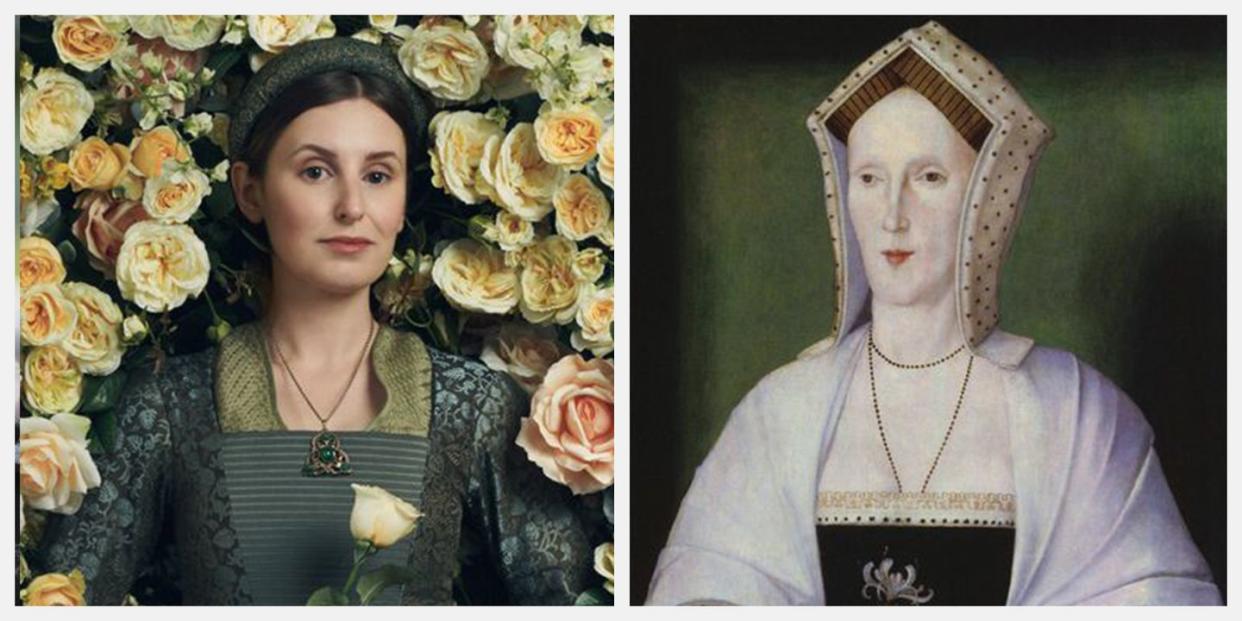What Margaret Pole, Laura Carmichael’s Character on The Spanish Princess, Was Really Like

- Oops!Something went wrong.Please try again later.
- Oops!Something went wrong.Please try again later.
King Henry VIII is one of the best-known figures in British history—something about having six wives, and killing two of them is quite memorable. But the Starz series The Spanish Princess doesn't center on Henry. Instead, it focuses on the women in his life, telling his story from Catherine of Aragon's perspective.
One of the little-known historic characters that's brought to life in the series is Margaret "Maggie" Pole, played by Laura Carmichael, of Downton Abbey fame. Here's what the woman was like in real life.
She was a Plantagenet, and one of the last surviving members of the House of York.
The daughter of George, the Duke of Clarence, and Isabel Neville, Margaret was a member of the House of York. (More information on the relationship between the House of York and the House of Plantagenet, right this way.) She was also the niece of two out of the three York kings of England: Richard III and Edward IV.
Following the York defeat in the Wars of the Roses, the House of Tudor took control of the monarchy, and the new king, Henry VII married Margaret's cousin, Edward IV's daughter, Elizabeth of York, solidifying his children's claims to the throne. Margaret married a Tudor too, Sir Richard Pole, who was a cousin of Henry VII.
"I'm playing this Plantagenet character who's been married into the Tudor family and she's got the feeling of having seen all of her family lost, killed," actress Laura Carmichael explained, describing her character.
Margaret was orphaned very early in life, and as The Spanish Princess shows, her brother, Edward Plantagenet, was first imprisoned in the Tower of London and later executed in 1499, to eliminate a potential claim to the English throne.

"It's such a difficult position for Maggie because on the one hand she feels like her family should still be there. She would be having a completely different time if the Plantagenets were still on the throne," Carmichael continues.
"But also, she loves her husband. She's loyal to him. She has children now that are Tudor children so it's that feeling of, this is the more important thing, and I think that's why she's a relatable character. Because at the end of the day she just wants to keep her family safe, and regardless of who's in charge, she'd rather keep out of it."
Showrunner Emma Frost sees the character as the "moral barometer of the show."
"I think Maggie is us in the situation," Frost told Harper’s Bazaar.
"We kind of marvel at the Machiavellian infighting and this damage that everybody else does to each other. She has such moral sense and such a good soul."
In total, Margaret and Richard Pole had five children together: Henry, Arthur, Ursula, Reginald and Geoffrey.
Following Richard's death in 1504, Margaret no longer had the fortune to support her family, and she had to give Reginald to the church to be educated to ease her financial burden. He would eventually go on to become last Roman Catholic Archbishop of Canterbury in history under Queen Mary I.

Margaret's fortune shifted when Henry VIII became king.
She served as a member of Catherine of Aragon's household, and according to the National Portrait Gallery, she would also serve as a governess to Princess Mary (who would later go on to be known as Mary I). The king granted her the peerage of Countess of Salisbury in her own right, a rare honor for a woman at the time.
But eventually Henry VIII chose to break with the Catholic church in order to divorce Catherine of Aragon and marry Anne Boleyn. Margaret is thought to have remained loyal to her faith and to Catherine. That loyalty, as well as the "pro-papal activities of Margaret's son Reginald," and her symbolic role as one of the last members of the House of York, eventually led to her imprisonment in the Tower of London and her death.
In 1541, she was executed for treason.
Her death was, by all accounts, a horrific experience. She was killed by axe, and is not thought to have gone quickly.
She was beatified by the Catholic Church in 1886 as a martyr for her faith.
The church celebrates her feast day on May 28 each year.
You Might Also Like

